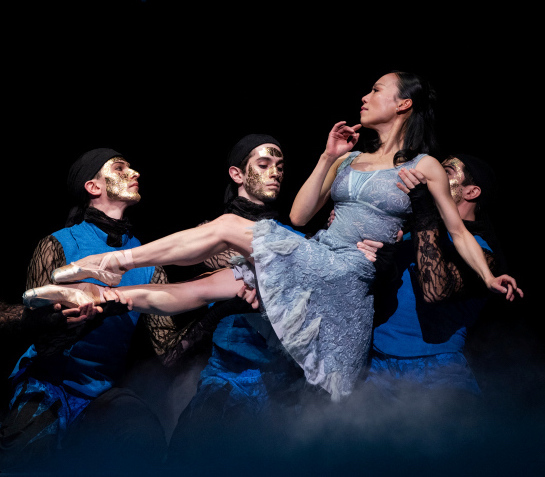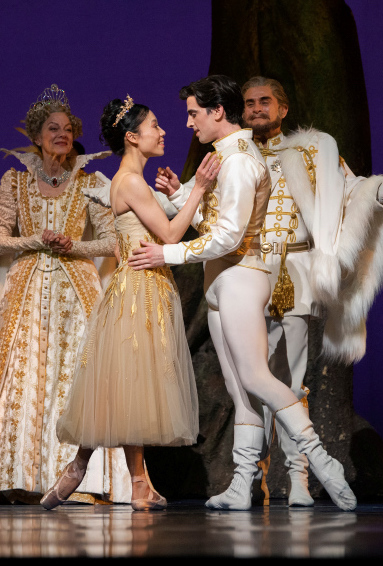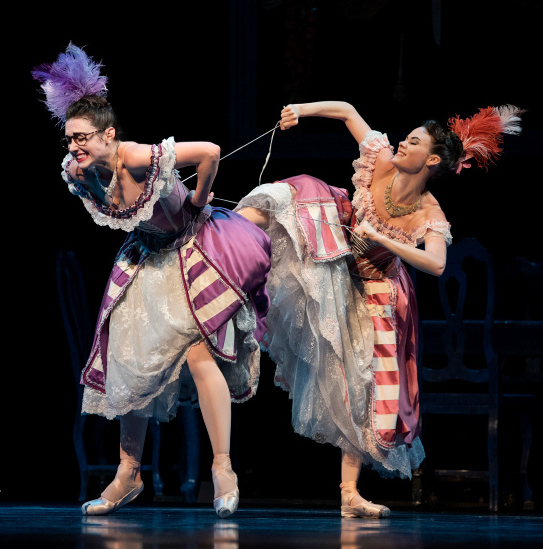Figures in deep blues and green whirl across the stage to a hectic waltz by Prokofiev. Above them a clutter of candelabras shines down like stars in the night sky, and two figures, a prince in a deep red jacket with military decorations and a young woman in a dress covered in pheasant feathers and wearing a gold mask and gold slippers, appear and disappear among the whirling figures. They lose each other, they find each other.
The scene, from San Francisco Ballet’s production of Christopher Wheeldon’s Cinderella, was not unlike the previous one where the spirits of spring, summer, fall and winter spun in colorful groups across a magical forest to teach Cinderella the dances she will take to the royal ball. With a field of stars above, the rustling leaves of a magical tree grew, shifted and danced and transformed the young woman into a princess fit for a dashing, though rather rebellious, young prince. Once garbed in gold and feathers she rose on the backs of spirits as they became an exotic wind-blown chariot, wheels of flowers turning beneath her.

The co-production with the Dutch National Ballet, which premiered in San Francisco Ballet in 2013 and returned again a few years later, is one of the most magical interpretations of the fairy tale ballet to hit the stage since the Bolshoi premiered Prokofiev’s music in their original production in 1945. Since then a number of interpretations have been set, including ones by Baryshnikov and Nureyev. Wheeldon’s may be the most magical interpretation of any fairy ballet, period, in a genre that specializes in retelling the most primal of our stories about love and transformation.
Part of that is due to Wheeldon and librettist’s Craig Lucas’ choice to use the Brother Grimm’s version rather than the more familiar Perrault story, which was written as a charming moralizing tale for the children of the privileged French. He wrote, knowingly, “it is a great advantage to have intelligence, courage, good breeding, and common sense. These, and similar talents come only from heaven, and it is good to have them. However, even these may fail to bring you success, without the blessing of a godfather or a godmother.”
There is no godmother in Wheeldon’s Cinderella, only the elemental forces of nature – at times fairy, at times grotesque, or terrifying – unleashing nature’s creatures and a power that lies underneath life and comes from the dead’s ever-present power to change us.

These forces are manifest on stage by Designer Julian Crouch and his collaborator Basil Twist. Together, along with Lighting Designer Natasha Katz, they choreograph sets, costumes and videos into a dynamic weave that enhances and uplifts Wheeldon’s ballet, especially in the forest transformation scene, which is both breathtaking and awesome.
Wheeldon in turn gives the performers a psychological depth that is seldom seen in narrative ballets, especially the sugarcoated fairy tales. The prince, danced on opening night by the wonderful Joseph Walsh, is a bit of a ruffian good boy, impetuous and given to pranks with his best mate Benjamin, danced by Esteban Hernandez. Cinderella is prone to high emotions and disappointment, unable to keep from antagonizing her equally willful stepmother. Frances Chung added fire to this characterization. Both Walsh and Chung are miraculously beautiful dancers.
Everyone in the extraordinary large cast was absolutely dead on in all their balletic glory.

Comedy and pantomime are a large part of this ballet and Wheeldon has very closely followed Prokofiev’s music to develop his narrative, especially in the first part of the ballet when the more complex story is developed. His choreography is very British in style, despite his many years outside of the UK working for international companies, and there is much that is similar to his fellow British choreographer Cathy Marston. Both have a strong narrative drive and lean toward steps that are dance-y rather than neo-Classical. Their formalism has more to do with synchronicity of the corps than the cool complications of the body in movement.
– Jaime Robles
SF Ballet’s Cinderella continues through February 2 at the War Memorial Opera House. For tickets and information, visit sfballet.org.